Denarii Meaning In The Bible: Value and Justice
In the Bible, the denarius was a Roman silver coin that served as a standard unit of currency, equivalent to a day’s wage for a laborer. Its frequent mention in the New Covenant illustrates its central role in the economic and social life of ancient Judea.
The parables of Jesus, such as the Workers in the Vineyard (Matthew 20:1-16) and the Tribute to Caesar (Matthew 22:15-22), use the denarius to highlight themes of fairness, responsibility, and divine justice. This coin symbolized societal norms and the intersection of economic and spiritual duties, offering deeper insights into biblical teachings.

Denarii Meaning in the Bible: Currency, Value, and Biblical Lessons
| Aspect | Description |
|---|---|
| Definition | Roman silver coin used during New Testament times |
| Approximate Value | Equivalent to a day’s wage for a laborer |
| Biblical References | Matthew 20:2, Luke 7:41, John 6:7 |
| Use in Parables | Featured in lessons on fairness, forgiveness, and stewardship |
| Symbolism | Represents material value and economic transactions |
| Teaching Example | Parable of the Workers in the Vineyard (Matthew 20) |
| Spiritual Insight | Illustrates God’s grace, justice, and generosity |
| Relevance Today | Encourages fair treatment, gratitude, and wise stewardship of resources |
Historical Background of Denarii

The historical background of denarii encompasses the evolution of this Roman silver coin from its inception during the Republic era to its significant role in the economic and social frameworks of the ancient world.
Introduced circa 211 BCE, the denarius emerged as a standardized currency, pivotal in facilitating trade, military payments, and daily transactions. Initially struck with a weight of approximately 4.5 grams of silver, it bore the imagery of Roman deities and symbols, reflecting the cultural and political ethos of its time.
Over centuries, the denarius underwent various modifications in weight and design, mirroring the fluctuating fortunes and reforms of the Roman state. Its widespread circulation underscores its integral function in the expansive Roman economy and society.
Denarius in Roman Economy
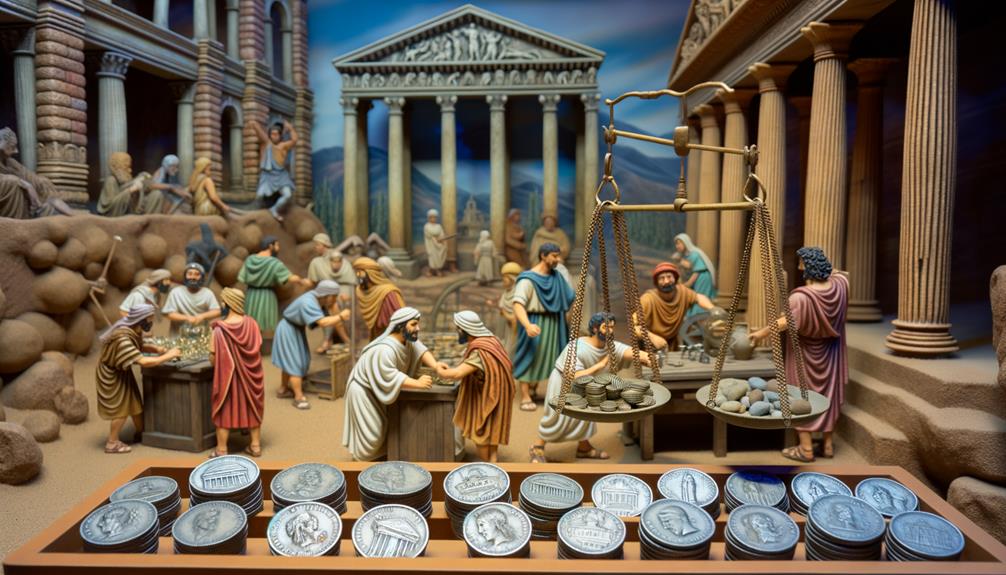
In the Roman economy, the denarius served as a principal silver coin, reflecting its substantial value in monetary transactions.
It was not only a standard measure for common wages, often equating to a day’s labor, but also played a pivotal role in various economic exchanges, influencing pricing and market stability.
Analyzing the denarius offers valuable insights into the economic structures and societal norms of ancient Rome.
Denarius: Roman Currency Value
Functioning as a fundamental unit of monetary exchange in the Roman Empire, the denarius held significant value both economically and socially, influencing various aspects of daily life and commerce.
Minted in silver, the denarius was introduced around 211 BCE and quickly became the backbone of Roman currency. Its value was standardized, making it a reliable measure for transactions, taxation, and savings.
The denarius facilitated trade, not only within the vast reaches of the Roman Empire but also with neighboring territories, promoting economic integration.
Its stability and widespread acceptance underscored the economic prowess of Rome, reflecting the Empire’s ability to control and manage its resources effectively.
This currency deeply impacted financial systems, legal transactions, and even social hierarchies.
Denarius: Common Wages Indicator
Serving as a key indicator of common wages in the Roman economy, the denarius was often employed to measure daily labor compensation, reflecting its central role in both economic transactions and societal structure. Its widespread usage as a standard of payment underscores several important aspects:
- Daily Wage: Typically, a single denarius was the standard daily wage for a laborer.
- Military Pay: Roman soldiers commonly received denarii as part of their pay.
- Economic Stability: The consistent value of the denarius provided economic stability.
- Social Hierarchy: Wages in denarii highlighted the economic status of various social classes.
This underscores the denarius’s significance as a wage indicator in Roman society.
Denarius: Economic Transactions Role
The denarius played a pivotal role in facilitating economic transactions within the Roman economy, acting as a widely accepted medium of exchange and a reliable unit of account.
Its standardized silver content guaranteed its credibility and uniformity, making it indispensable for both local and long-distance trade.
This currency not only enabled the efficient collection of taxes but also facilitated the payment of wages, thereby underpinning various economic activities.
Additionally, the denarius served as a benchmark for pricing goods and services, promoting market stability and transparency.
Its widespread use across the Roman Empire exemplifies its integral function in sustaining economic cohesion and fostering commercial growth, illustrating the sophisticated monetary system that underpinned Roman economic prosperity.
Biblical References to Denarii

Denarii are frequently mentioned in the New Scriptures, often in the context of parables and teachings of Jesus, serving as a standard unit of currency that helps to underscore various moral and theological points.
These references are pivotal in illustrating the economic realities of the time and enhancing the relatability of Jesus’ messages. Key instances include:
- Parable of the Workers in the Vineyard (Matthew 20:1-16)
- The Good Samaritan’s generosity (Luke 10:35)
- Judas Iscariot’s betrayal price (Matthew 26:15)
- The question of paying taxes to Caesar (Mark 12:15)
Each instance not only reflects the economic value of the denarius but also imbues the narrative with deeper ethical and spiritual insights.
Daily Wages and Denarii
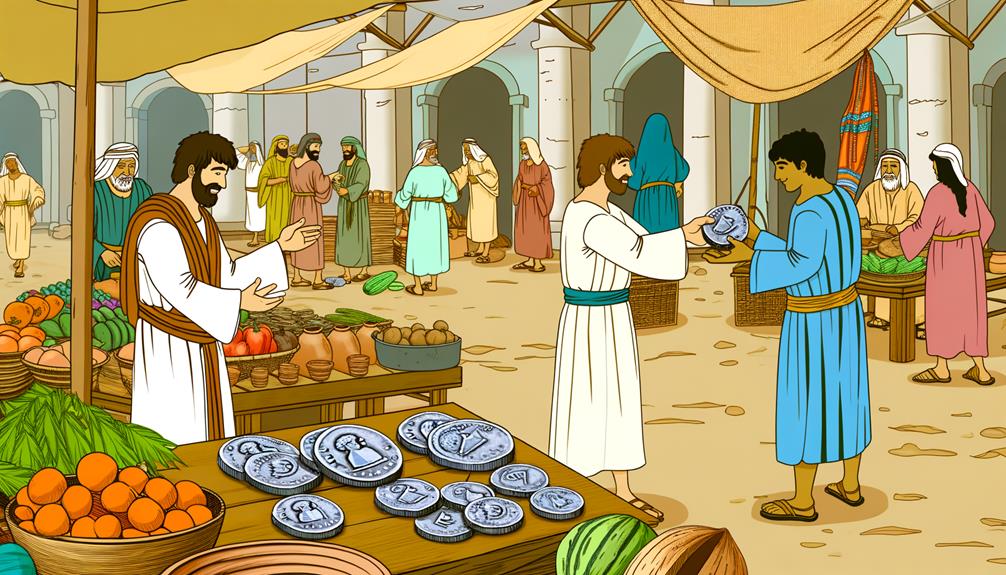
The denarius, a silver coin widely used in the Roman Empire, often represented a day’s wage for a laborer as evidenced by various biblical accounts.
This monetary standard provides critical insights into the economic conditions and labor practices of the time, allowing for a nuanced understanding of social and financial dynamics in biblical narratives.
Value of Denarii
In the economic context of the Roman Empire, a denarius commonly represented the daily wage for a laborer, reflecting its significant role in the financial and social structures of biblical times.
This coin, made of silver, was a fundamental unit of currency and provided a tangible measure of value for goods and services. The denarius is frequently mentioned in biblical texts, where its value can be understood through various references.
- Daily wage: Typically, one denarius equated to a full day’s work.
- Purchasing power: It could buy essential goods like food and clothing.
- Symbolic value: Often used to signify fairness in parables.
- Economic indicator: Reflects the economic conditions of the era.
- Standard measure: Basis for comparisons in monetary discussions.
Biblical Labor Practices
Understanding biblical labor practices involves examining the significance of daily wages, particularly the denarius, within the socio-economic framework of ancient times.
The denarius, a common Roman silver coin, was often referenced in biblical texts to denote a day’s wage for laborers, reflecting the economic realities and labor expectations of the period. This standardization of compensation underscores the structured nature of employment and the value placed on work.
For instance, in the Parable of the Laborers in the Vineyard (Matthew 20:1-16), the denarius highlights both the fairness and the generosity of the landowner.
The use of such monetary terms provides critical insight into the daily life, economic transactions, and social justice considerations in biblical narratives, offering a nuanced understanding of ancient labor dynamics.
Denarius in Jesus’ Parables
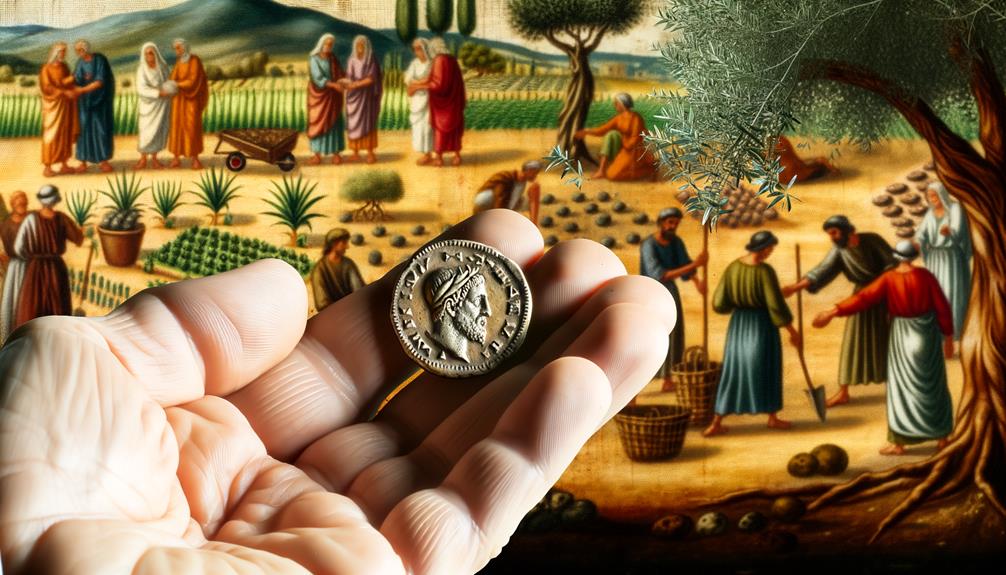
Throughout Jesus’ parables, the denarius serves as a powerful symbol of daily labor, economic exchange, and divine justice, reflecting the socio-economic realities of the time.
Importantly, the denarius is prominently featured in the Parable of the Workers in the Vineyard (Matthew 20:1-16), where it underscores themes of fairness and divine generosity. Here, workers receive a denarius regardless of hours worked, challenging prevailing notions of merit and reward.
The denarius also appears in the Parable of the Unforgiving Servant (Matthew 18:23-35), highlighting the magnitude of forgiveness.
Key points regarding the denarius in Jesus’ parables include:
- Representation of daily wages
- Symbol of divine justice and fairness
- Economic exchange medium
- Reflection of contemporary labor practices
Paying Taxes With Denarii
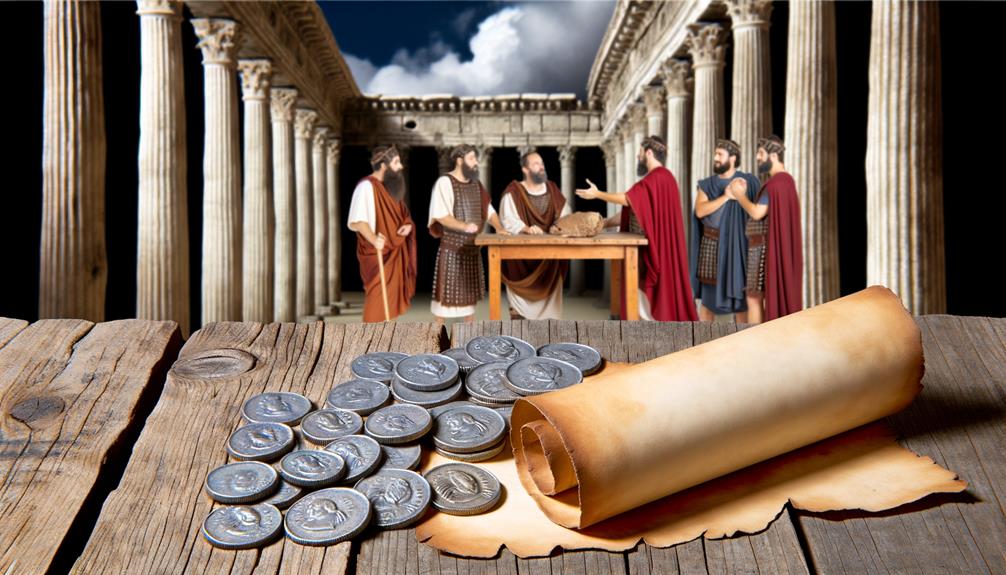
Building on the symbolic significance of the denarius in Jesus’ parables, its role in the context of paying taxes highlights the intersection of religious obligations and Roman imperial authority.
In Matthew 22:19-21, Jesus addresses the contentious issue of paying taxes to Caesar by asking for a denarius and pointing to Caesar’s image on the coin.
His response, ‘Render to Caesar the things that are Caesar’s, and to God the things that are God’s,’ transcends mere fiscal compliance. It underscores the dual responsibilities of believers: adherence to earthly governance and devotion to divine commandments.
The denarius consequently becomes a pivotal medium illustrating the balance between secular and spiritual duties, reflecting the nuanced relationship between faith and civic obligations.
Symbolic Meaning of Denarii

In biblical texts, the denarius serves as a multifaceted symbol, representing not only monetary value but also themes of justice, labor, and divine providence.
This coin’s significance extends beyond its economic function, encapsulating broader moral and theological principles.
Key symbolic aspects include:
- Justice: Reflecting equitable wages in parables, such as the laborers in the vineyard.
- Labor: Denoting an honest day’s work, often used to measure daily wages.
- Divine Providence: Illustrating God’s provision for human needs.
- Authority: Highlighting the governing power, as seen in Jesus’ teaching about rendering unto Caesar.
The denarius, consequently, acts as a rich, layered symbol in biblical narrative and doctrine.
Denarii in Ancient Judea
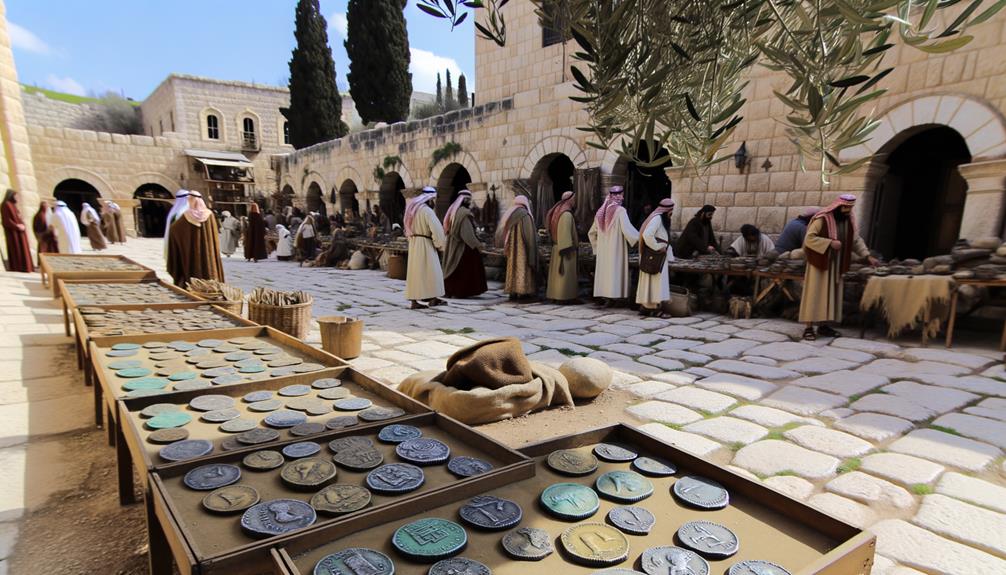
As a common currency in Ancient Judea, the denarius played an essential role in the economic, social, and political life of the region, reflecting broader socio-economic structures and cultural practices of the time.
The denarius facilitated trade, taxation, and daily transactions, becoming a symbol of Roman influence and authority. Archaeological findings and historical records illustrate its widespread usage and significance.
| Aspect | Details |
|---|---|
| Economic Role | Medium for trade, wages, and taxation |
| Social Impact | Standardized value for goods and services |
| Political Significance | Tool for Roman economic control |
| Cultural Reflection | Mirror of societal hierarchies and practices |
The denarius consequently not only served as a monetary unit but also as a lens through which the complexities of Ancient Judean society can be understood.
Denarius and Social Status
The denarius functioned as a critical indicator of social status in Ancient Judea, delineating the economic disparities and class distinctions within the society. As a standard silver coin, its possession and usage highlighted the hierarchical structure of Judean life. The denarius was emblematic of varying social strata, influencing one’s economic agency and societal interactions.
Key aspects include:
- Wages: A day’s labor, typically for a common worker, was often compensated with a single denarius.
- Wealth: Accumulation of denarii signified considerable wealth and influence.
- Transactions: Used extensively in both local and broader economic transactions.
- Taxation: Payment of taxes often required denarii, impacting lower-income groups disproportionately.
Understanding these dimensions elucidates the denarius’ role in shaping social dynamics.
Denarii in New Testament Stories

Throughout the New Scripture, the denarius emerges as a pivotal symbol in numerous parables and teachings of Jesus, often conveying deeper theological and moral lessons.
In the Parable of the Workers in the Vineyard (Matthew 20:1-16), the denarius represents the equality of God’s grace, irrespective of the time of one’s conversion.
Similarly, in the account of the Tribute to Caesar (Matthew 22:15-22), Jesus uses a denarius to delineate the boundaries between civic duty and divine allegiance.
Further, the Parable of the Unforgiving Servant (Matthew 18:21-35) employs the denarius to highlight the disparity between human indebtedness and divine forgiveness.
These narratives demonstrate the denarius’s role in illustrating complex spiritual truths through everyday economic transactions.
Lessons From Denarii in the Bible

Examining the denarius in biblical contexts reveals profound insights into the principles of divine justice, mercy, and the nature of God’s kingdom. These small silver coins were not just economic units but symbols laden with theological significance.
Key lessons include:
- Equity and Generosity: Parables like the Workers in the Vineyard highlight God’s equitable generosity.
- The Value of Faithfulness: The Parable of the Talents underscores the importance of stewardship and faithfulness.
- Divine Provision: Instances where denarii are used remind believers of God’s provision in times of need.
- Material and Spiritual Wealth: The denarius serves as a juxtaposition between earthly and heavenly treasures.
These lessons collectively deepen our understanding of divine principles.
Conclusion
The denarius, integral to both the Roman economy and biblical narratives, provides a profound lens through which one can understand socio-economic conditions of ancient Judea.
Particularly, a single denarius represented a typical day’s wage for a laborer, highlighting the coin’s significance in daily life and parables.
This monetary unit, mentioned over 30 times in the New Covenant, underscores its pivotal role in illustrating moral and ethical lessons within biblical texts.
Analyzing these references offers enriching insights into historical and theological contexts.






